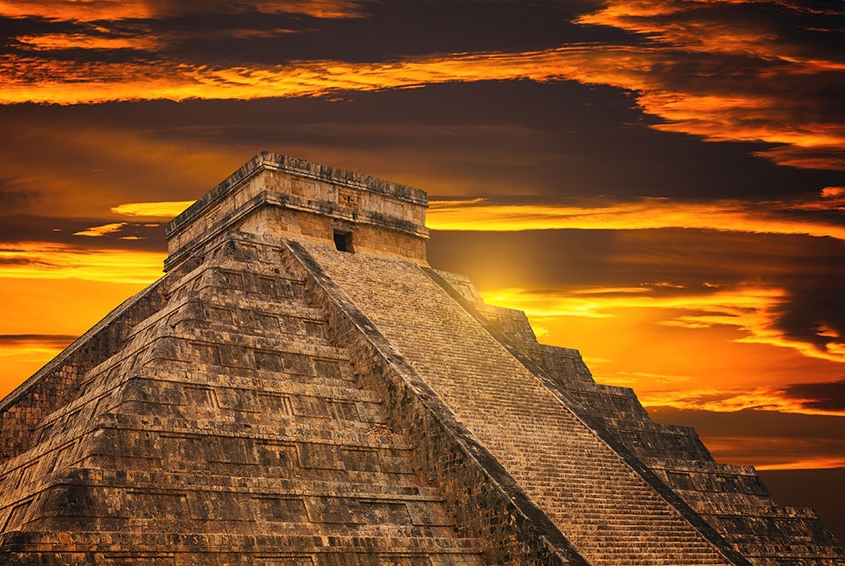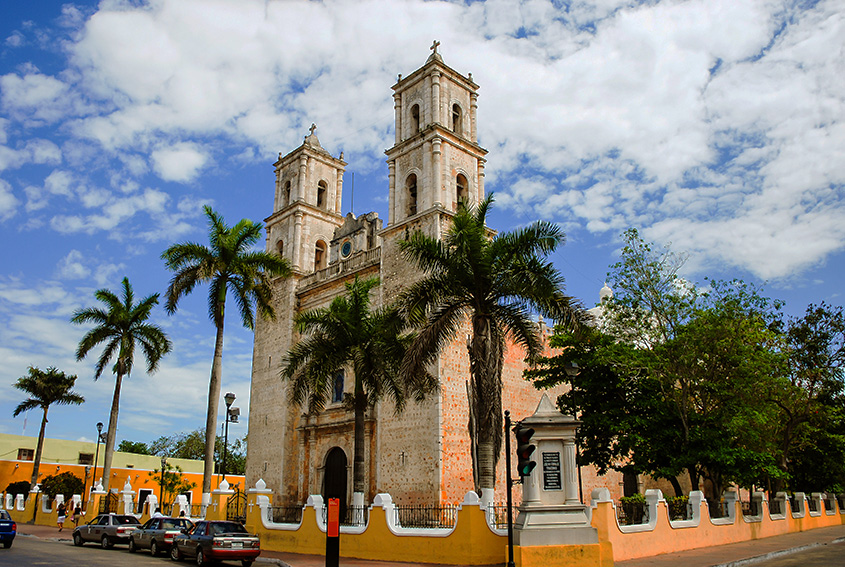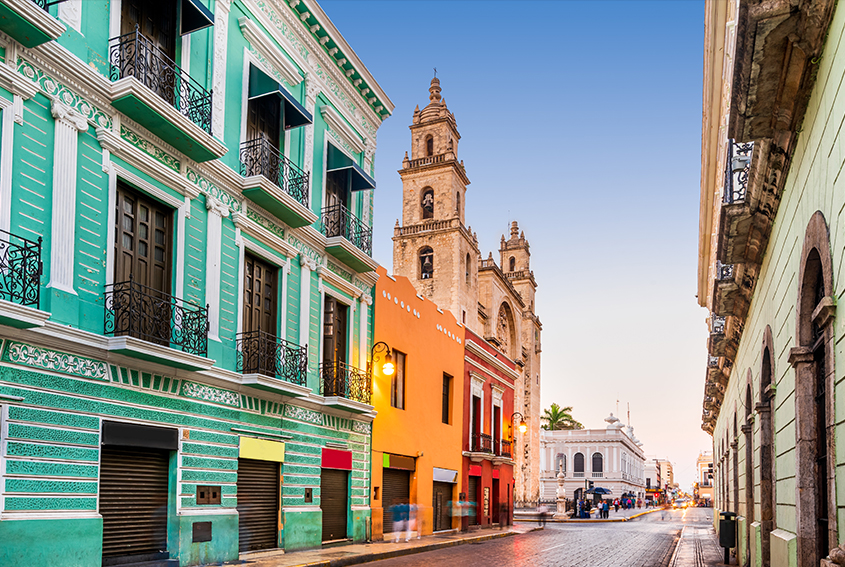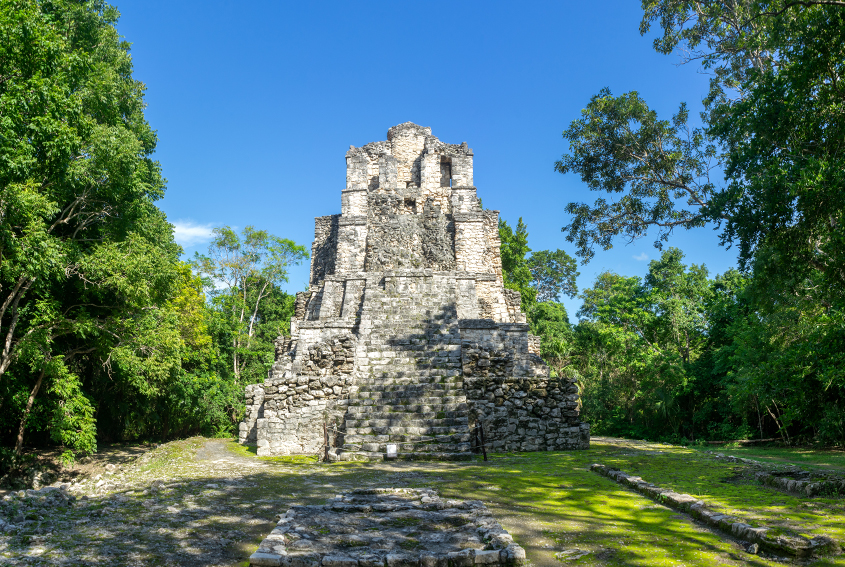Discover more of the Yucatan Peninsula
A world of wonders awaits you beyond the spectacular beaches of Cancún and the Riviera Maya so why not go exploring this summer? Thomas More Travel offers tours to many of them and can also help you arrange a private tour with a vehicle, driver and guide so that you can see more of the area at your own pace and leave the driving to someone else.
Yucatan’s Pueblos Mágicos
If you have been to Chichen Itza and Ek Balam, the ancient Maya cities in eastern Yucatan, how about spending the day wandering through the Yucatan’s colonial twin towns or Pueblos Magicos (Magical Towns) Valladolid and Izamal? Both are rich in history and traditions and surrounded by cenotes, archaeological sites and haciendas.
In Valladolid you can stroll through the main square dominated by the 17th century San Servacio Cathedral, see colorful murals in the Town Hall and traditional folk dances in the park, shop for crafts and dine in a lovely colonial-style courtyard.
Casa de los Venados is a privately owned home in a restored 17th-century casona on Calle 40 a few steps from the main square that is filled with the owners’ collection of over 3,000 items of folk art from all over Mexico. Colorful ceramics and textiles share space with woodcarvings, copper, sculptures and paintings, treasures of creativity and humor. Guided tours are available at 10 a.m. (Valladolid time).
From the main square, walk along the Calzada de Los Frailes to visit the 16th-century San Bernardino Church and Sisal Convent. Be sure to call in at the La Casona restaurant to see the impressive shrine and fountain built from fragments of Talavera pottery to honor the Virgen de la Candelaria, the patron saint of Valladolid.
Located in front of Parque San Juan, the Mexican Ethnic Clothing Museum (MUREM) has a collection of traditional outfits from 12 different regions of Mexico and is still growing. The beauty and color of everyday garments and ornate dresses worn for fiestas is on display and every garment has a story to tell.
On the outskirts of Valladolid is the Mayapan distillery that produces a liquor from the blue agave of tequila fame. Tours are available and you can see how the agave piñas are cooked and crushed to extract the sugar-sweet sap, which is then fermented and distilled using a time-honored artisanal technique.
Ten blocks from the center of Valladolid is Xkopek, a park where you can learn about the ancient tradition of beekeeping in the Yucatan. Your guide will tell you about the native Melipona stingless bee and how the Maya have been tending bees and producing honey for thousands of years. They even venerated a bee god called Ah Mucen Cab.
You’ll want to cool off with a swim in a cenote and the Valladolid area is peppered with these beautiful natural wells. Visit Dzitnup and Samula, Cenote Oxman, Suytun, Hubiku in Temozon or Ik-kil near Chichen Itza.
Heading on to Izamal, two historic monuments dominate the skyline: the Kinich Kakmo pyramid, one of the largest ancient buildings in Mesoamerica, and the 16th-century Convento de San Antonio de Padua painted in dazzling yellow and with a white trim. Built by the Franciscan order, this sprawling monastery has one of the largest atriums in the world and is a shrine to the Virgin of the Immaculate Conception, patron saint of the Yucatan.
Izamal is home to families of craftsmen and women, and you can watch them at work during a walking tour of neighborhoods in different parts of town. Some are hammock weavers or earn their living embroidering traditional huipil dresses and blouses. Others make papier mâché butterflies and birds or silver jewelry from the woody tips of henequen leaves.

More wonders in Eastern Yucatan
Spend the day exploring more historic and natural wonders in eastern Yucatan. Visit the mighty Maya metropolis of Chichen Itza, a UNESCO World Heritage Site or Ek Balam, a smaller archaeological site 20 minutes to the north of Valladolid.
Nature lovers will want to explore Ria Lagartos Biosphere Reserve, an area of mangroves, lagoons and salt flats along the Gulf coast to see flamingos, herons, roseate spoonbills, pelicans, kingfishers and other birds. On a boat trip from the fishing village of Rio Lagartos, you may even see the crocodiles or lagartos that give the reserve its name.
Summer is flamingo nesting season, and boatmen are not permitted to go as far as the area in the reserve where they build their pedestal nests out of clay so as not to disturb the skittish birds. This year, for reasons unknown, it appears that thousands of them have migrated to nest in lagoons further west along the coast around San Crisanto, but visitors are still likely to spot them feeding in the Ria Lagartos wetlands.
Merida and Uxmal
Head for Merida, capital of the Yucatan, and stroll through the main square and surrounding colonial neighborhoods, visiting 16th and 17th century churches and the opulent mansions of the henequen planters along Paseo de Montejo. Take in the city’s museums and shop for Yucatecan and Mexican folk art and clothing in galleries and markets.
From folk dancing to live music, video screening, street theater and the reenactment of the Maya ball game, there is a different cultural event every evening and you’ll enjoy the varied dining scene. A table under the trees in a plaza with views of an old church is the perfect spot for a meal and a traditional trova serenade performed by a local guitar trio will capture the ambiance of Merida.
You can also use Merida as a base for exploring more of Yucatan. The Gulf coast port of Progreso is only 20 minutes away and you may want to call in at the archaeological site of Dzibilchaltun en route. An hour’s drive from Merida heading south is a low range of hills called the Sierra Puuc. This area gave its name to architectural and artistic styles that flourished in a chain of ancient cities now known as the Puuc Route, collectively designated as UNESCO World Heritage Site. The most famous is Uxmal and it dominated the smaller cities of Kabah, Sayil, Xlapak and Labna.

Uxmal is a masterpiece of ancient architecture and art, its temples and palaces decorated with stucco carvings and friezes depicting Chaac, the rain god, rulers, serpents and sacred birds and turtles, among others.
After your Uxmal visit, you may want to visit Choco Story, a museum at nearby Hacienda Uxmal hotel. Learn about cacao, Mexico’s gift to the world, its importance for the Olmec, Maya and Aztec cultures and how the Spaniards first sampled the frothy xocolatl drink at the court of the Aztec emperor Moctezuma. They added honey to it and shipped it back to Spain where hot chocolate soon became the preferred drink of the European aristocracy. The rest is history, and all will be told as you discover how cacao is grown, harvested and processed to make chocolate.
Other options are to visit some of the restored haciendas in the area or take a guided tour of Loltun Caves. You can also return to Merida via the Convent Route, a chain of villages with colonial churches, caves, cenotes and archaeological sites that starts with picturesque Mani, another Pueblo Mágico, and includes Oxkutzcab, Mama, Teabo, the archaeological site of Mayapan and Acanceh.
Southern Quintana Roo
Alternatively, turn your sights south from the Riviera Maya and head for central and southern Quintana Roo. Discover the ancient Maya sites of Muyil and Chacchoben and the historic town of Felipe Carrillo Puerto in the Zona Maya.
If you would like to meet the Maya and learn more about their lives, Maya Ka’an is a collection of community and nature tours taking you to villages in Sian Ka’an Biosphere Reserve and the Zona Maya such as Tihosuco, Señor, Chunhuhub and Noh Bec.
Divers and fishermen will want to make a beeline for the Caribbean fishing villages of Mahahual and Xcalak on the Costa Maya. Dive trips are available to Banco Chinchorro, a spectacular coral atoll rich in marine life with a crystal-clear lagoon and several cays that are a haven for seabirds and crocodiles.
The jagged reefs have been the downfall of many a ship down the ages. Spanish galleons, 19th-century merchantmen and modern cargo vessels have all foundered on Chinchorro in storms and archaeologists have detected dozens of wrecks, some of which are also dive sites.
Further south is spectacular Bacalar, the Lagoon of Seven Colors, the perfect spot to reconnect with nature and unwind in a waterfront cabaña. Local attractions include San Felipe, a colonial fort built to defend the village from pirate attacks and Cenote Azul.
On the shores of Chetumal Bay, the state capital Chetumal still has some wooden gingerbread houses that evoke its Caribbean heritage and the Museum of Maya Culture, an introduction to the ancient civilization, its history, economy, society and religion.
Once an important Maya trade center inhabited from 600 BC to AD1100, the crumbling palaces and temples of Oxtankah lie in the forest near Chetumal Bay. The ruins of a chapel built by Spanish missionaries in the 16th century also lie on the site.
Archaeologists believe that southern Quintana Roo was home to more than a million people during the Classic period of Maya history when the area was dotted with cities. Heading west from Chetumal, you can visit some of these archaeological sites such as Kohunlich and Dzibanche-Kinichna.
Continue west and you’ll enter the state of Campeche where there are more archaeological sites to explore, including Xpuhil, Becan, Chicanna, Rio Bec and Balamku. For an unforgettable trip into the wild, visit the ancient Mayan capital of Calakmul, designated a UNESCO World Heritage Site for its monuments and the biodiversity of the jungle protected by the vast Calakmul Biosphere Reserve.
Go Exploring with Thomas More Travel
Start choosing your tours now with Thomas More Travel and ask about private tours and sightseeing itinerary ideas.



